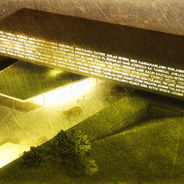Museum of Troy

decontextualized experience
Museum of Troy, 2011
Archeology museums detach historical objects from their temporal and spatial contexts, and reconfigure the context to make knowledge accessible for the audience. Our proposal for the Museum of Troy seeks the architectural representation of decontextualization. In this sense, the archeological findings are exhibited in a context-independent flying box. The physically-decontextualized exhibition block is wrapped with the story of lliad, a myth that defines the ancient city of Troy. Through this reference, the museum is rendered as a structure in-between reality and myth, temporalities and spatialities.
Interior circulation and the myth envelope convert the exhibition block to an exhibition in itself, which can be experienced both from interiors and exteriors. The myth envelope also serve as a sunshade that aid in controlling the amount of direct sunlight in the structure.
The proposal devises an incision that is detached from the context and the exhibition block touches this incision only via vertical circulation shafts. The incision links the buried social functions and leads to the site of the necropolis. In other words, the decontextualized museum transforms the existing context wherever it touches the ground and founds its own context, in a manner similar to the famous Trojan Horse...


Visuals

Information
LOCATION // Çanakkale, Turkey
CONS. AREA // 8000m²
CLIENT // Ministry of Culture and Tourism (National Competition)
TEAM // Onur Özkoç, Heves Beşeli, Duygu Tüntaş, Fadime Yılmaz










